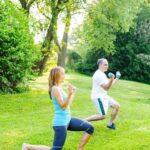Embarking on a fitness journey can be both exciting and overwhelming. The decision to prioritize your health and well-being is the first step towards a better quality of life. In this section, we’ll discuss the significance of beginning a fitness lifestyle and how to take those initial steps towards a healthier you.
Many individuals often wonder how to begin a fitness lifestyle but are unsure where to start. Engaging in regular physical activity and making mindful dietary choices are fundamental components of leading a healthy lifestyle. By understanding the importance of prioritizing fitness, individuals can make informed decisions about their health and well-being as they embark on this transformative journey.
Starting a fitness lifestyle encompasses more than just hitting the gym or going for a run; it’s about making sustainable choices that support overall well-being. From setting realistic goals to finding motivation and overcoming challenges, each aspect plays an integral role in establishing a lifelong commitment to your fitness journey. Understanding these key elements will help lay the foundation for success as you begin your transformation.
Setting Goals
Understanding the Importance of Goal Setting
Setting fitness goals is an essential step in beginning a fitness lifestyle. By establishing clear and achievable objectives, individuals can create a roadmap for success and measure their progress along the way. Whether the goal is to lose weight, build muscle, or simply improve overall health, having a specific target to work towards can provide motivation and direction.
Establishing Realistic and Achievable Goals
When setting fitness goals, it is important to be realistic and consider individual abilities and limitations. It’s essential to set goals that are challenging yet attainable, taking into account factors such as time availability, current fitness level, and any potential obstacles. By setting realistic goals, individuals are more likely to stay motivated and committed to their fitness journey.
The SMART Approach
One effective method for setting fitness goals is using the SMART approach – Specific, Measurable, Achievable, Relevant, and Time-bound. This framework helps individuals create clear and actionable objectives that can be tracked and evaluated over time.
For example, instead of setting a vague goal like “I want to get in shape,” a SMART goal would be “I want to lose 10 pounds in the next three months by exercising three times a week and following a balanced diet.” Applying the SMART criteria can make goal-setting more structured and effective in driving progress towards a healthier lifestyle.
By understanding how to begin a fitness lifestyle with proper goal-setting techniques, individuals can lay the groundwork for long-term success on their fitness journey. Establishing realistic goals based on personal abilities and utilizing strategies such as the SMART approach can help individuals stay focused, motivated, and committed as they work towards achieving their desired level of physical wellness.
Finding Motivation
When it comes to beginning a fitness lifestyle, motivation is key. Without the drive and determination to get started and keep going, it can be challenging to maintain a regular exercise routine and healthy eating habits. Here are some tips on how to find the motivation you need to pursue a fitness lifestyle:
1. Identify your reasons: Take some time to reflect on why you want to begin a fitness lifestyle. Whether it’s to improve your overall health, lose weight, gain muscle, or simply feel better about yourself, understanding your reasons can help fuel your motivation.
2. Set specific goals: Once you’ve identified your reasons for wanting to pursue a fitness lifestyle, set specific and achievable goals for yourself. Whether it’s running a certain distance, lifting a particular weight, or fitting into a certain size of clothing, having clear objectives can give you something concrete to work towards.
3. Find inspiration: Look for sources of inspiration that resonate with you. This could be success stories from others who have embarked on their own fitness journeys, motivational quotes, or images that represent the vision you have for yourself.
By understanding what drives you and setting specific goals, you can find the motivation necessary to begin and sustain a fitness lifestyle.
Choosing the Right Exercise
When beginning a fitness lifestyle, it’s important to explore different types of workouts to find what works best for you. There are various exercises and physical activities that can help you achieve your fitness goals, so it’s essential to choose the right ones that align with your interests and fitness level. Here are some tips on how to choose the right exercise for you:
1. Identify Your Fitness Goals: Before starting any workout routine, it’s crucial to identify your fitness goals. Whether you want to lose weight, build muscle, improve endurance, or simply stay active, understanding your objectives will help you select the most suitable exercises.
2. Explore Different Workout Options: There are countless workout options available, including cardiovascular exercises, strength training, yoga, Pilates, and more. Take the time to explore various workout styles and find activities that resonate with you.
3. Consider Your Preferences and Lifestyle: When choosing the right exercise, consider your preferences and lifestyle. If you enjoy being outdoors, activities like hiking or cycling may be a good fit for you. Similarly, if you prefer group settings, classes like Zumba or spin might be more appealing.
4. Start Gradually and Progressively: It’s important to start gradually and progressively with your chosen workouts. This will help prevent injuries and allow your body to adapt to new physical activities over time.
By carefully considering these factors and exploring different types of workouts, you can find the right exercise that suits your interests and abilities as you begin your fitness journey. Remember that consistency is key when it comes to achieving long-term fitness results.
Creating a Nutrition Plan
When embarking on a fitness journey, one of the key components to consider is creating a nutrition plan. Understanding the role of diet in fitness and developing a healthy eating plan can significantly impact your overall health and ability to achieve your fitness goals. Here are some essential sub-sections to consider when creating a nutrition plan:
Understanding the Role of Diet in Fitness
The food you consume plays a crucial role in your fitness journey. It provides the necessary fuel for your body to perform at its best, aids in muscle recovery, and contributes to overall well-being. Understanding how different nutrients, such as carbohydrates, proteins, fats, vitamins, and minerals, affect your body can help you make informed decisions about your dietary choices.
Developing a Healthy Eating Plan
Creating a healthy eating plan involves thoughtful consideration of the types of foods you consume and the portion sizes. It’s important to include a variety of nutrient-dense foods such as fruits, vegetables, lean proteins, whole grains, and healthy fats in your diet. Planning balanced meals and snacks that provide the necessary nutrients while keeping calories in check is essential for sustaining energy levels throughout the day.
Maintaining Consistency
Consistency is key when it comes to maintaining a healthy eating plan. It’s important to develop sustainable habits that you can maintain over time. Instead of focusing on restrictive diets or quick fixes, aim for long-term lifestyle changes that support your overall health and wellness goals.
By understanding the role of diet in fitness and taking deliberate steps to develop a healthy eating plan, you can nourish your body effectively and support your fitness journey. Making mindful food choices and prioritizing nutrient-dense options will not only contribute to physical health but also enhance overall well-being.
Investing in the Right Gear
When you’re just starting a fitness lifestyle, having the right gear can make all the difference in your motivation and success. One of the most important pieces of equipment to invest in is a good pair of athletic shoes.
Proper footwear can prevent injuries and provide support for different types of workouts such as running, weightlifting, or group exercise classes. Additionally, investing in comfortable workout clothing that allows for ease of movement and wicks away sweat can enhance your overall workout experience.
For strength training, consider purchasing a set of dumbbells or resistance bands to use at home or at the gym. These versatile tools can be used for a wide variety of exercises and are essential for building muscle and increasing strength. If you’re interested in cardio workouts but prefer to do them at home, a jump rope or stationary bike could be valuable additions to your fitness equipment collection.
It’s also important to remember that hydration is key to a successful workout routine, so investing in a good water bottle that you can take with you on-the-go is essential. Staying hydrated before, during, and after your workouts is crucial for overall health and performance.
Lastly, if you’re planning on working out from home rather than at a gym, it may be beneficial to invest in some basic home gym equipment like an exercise mat, stability ball, or foam roller. These items can help add variety to your workouts and assist with recovery after intense exercise sessions.
| Fitness Equipment | Benefits |
|---|---|
| Athletic shoes | Prevents injuries and provides support |
| Dumbbells or resistance bands | Versatile tools for strength training |
| Jump rope or stationary bike | Cardio options for home workouts |
| Water bottle | Key for staying hydrated during workouts |
Overcoming Challenges
Embarking on a fitness lifestyle can come with its fair share of challenges. From struggling to find time to exercise to facing setbacks in your progress, it’s important to understand that overcoming these obstacles is a natural part of the journey. One key aspect of dealing with setbacks and staying consistent in your fitness journey is adopting a positive mindset.
Instead of viewing challenges as roadblocks, see them as opportunities for growth and learning. This shift in perspective can help you stay motivated and resilient when faced with difficulties.
Another effective way to overcome challenges in your fitness journey is by setting realistic expectations. Understand that progress takes time and that setbacks are normal. By setting achievable goals and celebrating small victories along the way, you can maintain motivation even when facing obstacles. Additionally, seeking guidance from a fitness professional or mentor can provide valuable insight on how to navigate challenges and stay consistent in your fitness journey.
Staying consistent in your fitness journey also requires adaptability. Sometimes, unexpected circumstances may disrupt your routine, such as work commitments or family obligations. In these situations, it’s important to be flexible and adjust your approach to accommodate these changes.
Whether it’s finding alternative workout times or modifying your exercise plan, being adaptable can help ensure that setbacks do not derail your progress. By maintaining a positive mindset, setting realistic expectations, seeking guidance, and staying adaptable, you can overcome challenges and stay consistent on your path towards a healthier lifestyle.
Seeking Support
Building a support system and connecting with like-minded individuals in the fitness community is one of the most crucial steps in beginning a fitness lifestyle. Surrounding yourself with people who share similar goals and values can provide the encouragement, motivation, and accountability needed to stay committed to your fitness journey. Whether it’s joining a fitness class, finding a workout buddy, or becoming part of an online fitness community, seeking support can greatly impact your success.
One way to connect with like-minded individuals in the fitness community is by joining group fitness classes at a local gym or studio. Group classes not only provide structured workouts led by certified instructors but also offer an opportunity to meet new people who are also on their own fitness journey. Additionally, participating in group classes can help create a sense of camaraderie, making exercise more enjoyable and inspiring.
Another option for building a support system is to find a workout buddy. Having someone to exercise with can make the process more fun and rewarding. It also adds an element of accountability, as you are more likely to show up for workouts when someone else is relying on you. Whether it’s a friend, family member, or colleague, finding a reliable workout partner can significantly increase your chances of sticking to your fitness routine.
Finally, social media and online communities provide another avenue for connecting with like-minded individuals in the fitness world. Platforms such as Instagram, Facebook groups, and fitness forums allow you to engage with people who share similar interests and goals related to health and wellness. Engaging in these online communities can provide valuable support, inspiration, and resources as you navigate your own fitness lifestyle journey.
| Support System Option | Description |
|---|---|
| Group Fitness Classes | Structured workouts led by certified instructors that provide an opportunity to meet new people on their own fitness journey. |
| Workout Buddy | A reliable friend, family member, or colleague who can make exercising more fun while providing accountability. |
| Social Media & Online Communities | Platforms such as Instagram and Facebook groups that allow engagement with like-minded individuals sharing similar health and wellness goals. |
Conclusion
In conclusion, beginning a fitness lifestyle is a journey that requires dedication, commitment, and perseverance. By setting realistic and achievable fitness goals, finding the right motivation, choosing the appropriate exercise routine, creating a balanced nutrition plan, investing in the necessary gear, and seeking support from like-minded individuals, you can pave the way for a sustainable fitness journey.
It’s important to remember that starting a fitness lifestyle is not just about physical transformation; it’s also about improving your overall well-being and quality of life. By overcoming challenges and staying consistent in your efforts, you can build the foundation for long-term success in your fitness journey.
In embracing the journey towards a sustainable fitness lifestyle, remember to be patient with yourself and celebrate every small victory along the way. Whether it’s reaching a personal milestone or noticing improvements in your energy levels and mental clarity, each step forward is an achievement worth acknowledging. So take that first step today and begin your journey towards a healthier, fitter you.
Frequently Asked Questions
How Do I Start a Fitness Lifestyle?
Starting a fitness lifestyle begins with setting clear and achievable goals, whether it’s to lose weight, build strength, or improve flexibility. Find activities that you enjoy and make small changes to your daily routine, like taking the stairs instead of the elevator or going for a walk during lunch.
How Do I Start Exercising After Years of Inactivity?
After years of inactivity, it’s important to start slowly and gradually increase the intensity and duration of your workouts. Begin with low-impact exercises like walking, swimming, or gentle yoga to build up your strength and endurance before moving on to more challenging workouts.
How Do I Start a Fitness Journey From Scratch?
Starting a fitness journey from scratch requires a combination of commitment, patience, and consistency. Begin by consulting with a healthcare professional to ensure it’s safe for you to start exercising. Then start with simple activities like walking, stretching, or beginner-level workout videos before progressing to more intense workouts as your fitness improves.

Passionate about providing useful information to anyone with an interest in the field of Personal Training, I strive to pass on to our readers quality information and to answer any questions about Personal Trainers, the work they do and how to become one.





